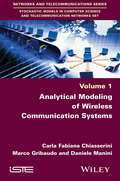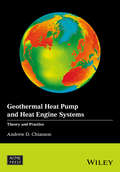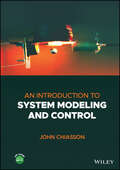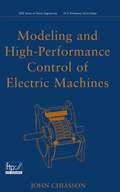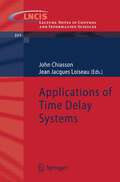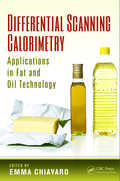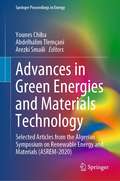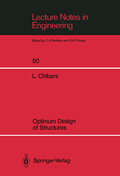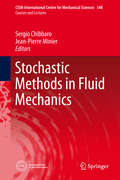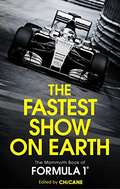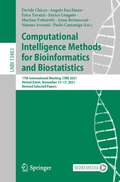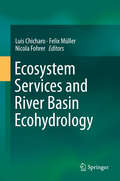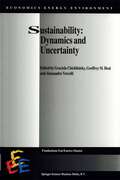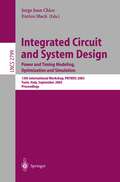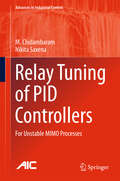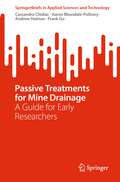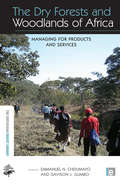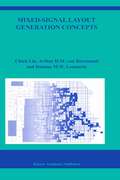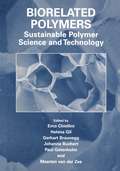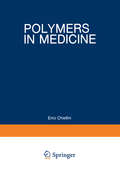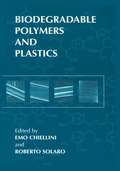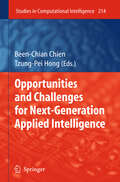- Table View
- List View
Analytical Modeling of Wireless Communication Systems
by Carla-Fabiana Chiasserini Marco Gribaudo Daniele ManiniWireless networks represent an inexpensive and convenient way to connect to the Internet. However, despite their applications across several technologies, one challenge still remains: to understand the behavior of wireless sensor networks and assess their performance in large-scale scenarios. When a large number of network nodes need to interact, developing suitable analytical models is essential to ensure the appropriate coverage and throughput of these networks and to enhance user mobility. This is intrinsically difficult due to the size and number of different network nodes and users. This book highlights some examples which show how this problem can be overcome with the use of different techniques. An intensive parameter analysis shows the reader how to the exploit analytical models for an effective development and management of different types of wireless networks.
Geothermal Heat Pump and Heat Engine Systems: Theory And Practice (Wiley-ASME Press Series)
by Andrew D. ChiassonA unique approach to the study of geothermal energy systems This book takes a unique, holistic approach to the interdisciplinary study of geothermal energy systems, combining low, medium, and high temperature applications into a logical order. The emphasis is on the concept that all geothermal projects contain common elements of a "thermal energy reservoir" that must be properly designed and managed. The book is organized into four sections that examine geothermal systems: energy utilization from resource and site characterization; energy harnessing; energy conversion (heat pumps, direct uses, and heat engines); and energy distribution and uses. Examples are provided to highlight fundamental concepts, in addition to more complex system design and simulation. Key features: Companion website containing software tools for application of fundamental principles and solutions to real-world problems. Balance of theory, fundamental principles, and practical application. Interdisciplinary treatment of the subject matter. Geothermal Heat Pump & Heat Engine Systems: Theory and Practice is a unique textbook for Energy Engineering and Mechanical Engineering students as well as practicing engineers who are involved with low-enthalpy geothermal energy systems.
Geothermal Heat Pump and Heat Engine Systems: Theory And Practice (Wiley-ASME Press Series)
by Andrew D. ChiassonA unique approach to the study of geothermal energy systems This book takes a unique, holistic approach to the interdisciplinary study of geothermal energy systems, combining low, medium, and high temperature applications into a logical order. The emphasis is on the concept that all geothermal projects contain common elements of a "thermal energy reservoir" that must be properly designed and managed. The book is organized into four sections that examine geothermal systems: energy utilization from resource and site characterization; energy harnessing; energy conversion (heat pumps, direct uses, and heat engines); and energy distribution and uses. Examples are provided to highlight fundamental concepts, in addition to more complex system design and simulation. Key features: Companion website containing software tools for application of fundamental principles and solutions to real-world problems. Balance of theory, fundamental principles, and practical application. Interdisciplinary treatment of the subject matter. Geothermal Heat Pump & Heat Engine Systems: Theory and Practice is a unique textbook for Energy Engineering and Mechanical Engineering students as well as practicing engineers who are involved with low-enthalpy geothermal energy systems.
An Introduction to System Modeling and Control
by John ChiassonA practical and straightforward exploration of the basic tools for the modeling, analysis, and design of control systems In An Introduction to System Modeling and Control, Dr. Chiasson delivers an accessible and intuitive guide to understanding modeling and control for students in electrical, mechanical, and aerospace/aeronautical engineering. The book begins with an introduction to the need for control by describing how an aircraft flies complete with figures illustrating roll, pitch, and yaw control using its ailerons, elevators, and rudder, respectively. The book moves on to rigid body dynamics about a single axis (gears, cart rolling down an incline) and then to modeling DC motors, DC tachometers, and optical encoders. Using the transfer function representation of these dynamic models, PID controllers are introduced as an effective way to track step inputs and reject constant disturbances. It is further shown how any transfer function model can be stabilized using output pole placement and on how two-degree of freedom controllers can be used to eliminate overshoot in step responses. Bode and Nyquist theory are then presented with an emphasis on how they give a quantitative insight into a control system's robustness and sensitivity. An Introduction to System Modeling and Control closes with chapters on modeling an inverted pendulum and a magnetic levitation system, trajectory tracking control using state feedback, and state estimation. In addition the book offers: A complete set of MATLAB/SIMULINK files for examples and problems included in the book. A set of lecture slides for each chapter. A solutions manual with recommended problems to assign. An analysis of the robustness and sensitivity of four different controller designs for an inverted pendulum (cart-pole). Perfect for electrical, mechanical, and aerospace/aeronautical engineering students, An Introduction to System Modeling and Control will also be an invaluable addition to the libraries of practicing engineers.
An Introduction to System Modeling and Control
by John ChiassonA practical and straightforward exploration of the basic tools for the modeling, analysis, and design of control systems In An Introduction to System Modeling and Control, Dr. Chiasson delivers an accessible and intuitive guide to understanding modeling and control for students in electrical, mechanical, and aerospace/aeronautical engineering. The book begins with an introduction to the need for control by describing how an aircraft flies complete with figures illustrating roll, pitch, and yaw control using its ailerons, elevators, and rudder, respectively. The book moves on to rigid body dynamics about a single axis (gears, cart rolling down an incline) and then to modeling DC motors, DC tachometers, and optical encoders. Using the transfer function representation of these dynamic models, PID controllers are introduced as an effective way to track step inputs and reject constant disturbances. It is further shown how any transfer function model can be stabilized using output pole placement and on how two-degree of freedom controllers can be used to eliminate overshoot in step responses. Bode and Nyquist theory are then presented with an emphasis on how they give a quantitative insight into a control system's robustness and sensitivity. An Introduction to System Modeling and Control closes with chapters on modeling an inverted pendulum and a magnetic levitation system, trajectory tracking control using state feedback, and state estimation. In addition the book offers: A complete set of MATLAB/SIMULINK files for examples and problems included in the book. A set of lecture slides for each chapter. A solutions manual with recommended problems to assign. An analysis of the robustness and sensitivity of four different controller designs for an inverted pendulum (cart-pole). Perfect for electrical, mechanical, and aerospace/aeronautical engineering students, An Introduction to System Modeling and Control will also be an invaluable addition to the libraries of practicing engineers.
Modeling and High Performance Control of Electric Machines (IEEE Press Series on Power Engineering #26)
by John ChiassonModeling and High Performance Control of Electric Machines introduces you to both the modeling and control of electric machines. The direct current (DC) machine and the alternating current (AC) machines (induction, PM synchronous, and BLDC) are all covered in detail. The author emphasizes control techniques used for high-performance applications, specifically ones that require both rapid and precise control of position, speed, or torque. You'll discover how to derive mathematical models of the machines, and how the resulting models can be used to design control algorithms that achieve high performance. Graduate students studying power and control as well as practicing engineers in industry will find this a highly readable text on the operation, modeling, and control of electric machines. An Instructor's Manual presenting detailed solutions to all the problems in the book is available from the Wiley editorial department. An Instructor Support FTP site is also available.
Applications of Time Delay Systems (Lecture Notes in Control and Information Sciences #352)
by John Chiasson Jean Jacques LoiseauThis book provides an update of the latest research in control of time delay systems and applications by world leading experts. It will appeal to engineers, researchers and students in Control.
Differential Scanning Calorimetry: Applications in Fat and Oil Technology
by Emma ChiavaroDifferential Scanning Calorimetry: Applications in Fat and Oil Technology provides a complete summary of the scientific literature about differential scanning calorimetry (DSC), a well-known thermo-analytical technique that currently has a large set of applications covering several aspects of lipid technology. The book is divided into three major s
Advances in Green Energies and Materials Technology: Selected Articles from the Algerian Symposium on Renewable Energy and Materials (ASREM-2020) (Springer Proceedings in Energy)
by Younes Chiba Abdelhalim Tlemçani Arezki SmailiThis book presents selected articles from the Algerian Symposium on Renewable Energy and Materials (ASREM-2020) held at Médéa, Algeria. It highlights the latest advances in the field of green energies and material technology with specific accentuation on numerical plans and recent methodologies designed to solve engineering problems. It includes mathematical models and experimental measurements to study different problems in renewable energy and materials characterization, with contributions from experts in both academia and industry, and presents a platform to further collaborations in this important area.
Optimum Design of Structures: With Special Reference to Alternative Loads Using Geometric Programming (Lecture Notes in Engineering #50)
by Lahbib ChibaniStochastic Methods in Fluid Mechanics (CISM International Centre for Mechanical Sciences #548)
by Sergio Chibbaro Jean-Pierre MinierSince their first introduction in natural sciences through the work of Einstein on Brownian motion in 1905 and further works, in particular by Langevin, Smoluchowski and others, stochastic processes have been used in several areas of science and technology. For example, they have been applied in chemical studies, or in fluid turbulence and for combustion and reactive flows. The articles in this book provide a general and unified framework in which stochastic processes are presented as modeling tools for various issues in engineering, physics and chemistry, with particular focus on fluid mechanics and notably dispersed two-phase flows. The aim is to develop what can referred to as stochastic modeling for a whole range of applications.
The Fastest Show on Earth: The Mammoth Book of Formula 1
by ChicaneIn the quest for ultimate speed, Formula One combines human drama, cutting-edge technological innovation and high-stakes finance in a thrilling global circus watched by half a billion avid fans.The Fastest Show on Earth brings the FIA Formula One World Championship vividly to life for everyone from first-time race-goers to avid fans wanting to delve even further into the Fastest Show on Earth. Experts from within the industry share their insights into the effect that recent revolutionary changes to regulations have had on engines, tyres, brakes, aerodynamics, fuel, safety and the use of data in a whole new era of racing. Races, rule changes and drivers are brought up to date in a comprehensive guide to the world's most viewed sport.This book is a superb technical guide, including circuit diagrams, team histories, driver profiles and a comprehensive glossary that offers fascinating insights into the inner workings of a world that offers everything from tragedy to thrilling triumph.From the cut-throat intrigue of the Piranha Club to the unsung heroism of pit lane, every aspect of Formula One is covered in compelling detail.Much more than just a sport and far more than a business, Formula One is a world of larger-than-life personalities and razor-sharp business people. The book also offers a window into the new Liberty Media regime and what the future may hold for the sport under new ownership.This extensive guide includes the official FIA circuit diagrams, team histories, driver profiles, circuit facts, technical braking profiles, a special section on the history of Formula One in the US and the most comprehensive glossary of Formula One terms ever compiled.
Computational Intelligence Methods for Bioinformatics and Biostatistics: 17th International Meeting, CIBB 2021, Virtual Event, November 15–17, 2021, Revised Selected Papers (Lecture Notes in Computer Science #13483)
by Davide Chicco Angelo Facchiano Erica Tavazzi Enrico Longato Martina Vettoretti Anna Bernasconi Simone Avesani Paolo CazzanigaThis book constitutes revised selected papers from the 17th International Meeting on Computational Intelligence Methods for Bioinformatics and Biostatistics, CIBB 2021, which was held virtually during November 15–17, 2021. The 19 papers included in these proceedings were carefully reviewed and selected from 26 submissions, and they focus on bioinformatics, computational biology, health informatics, cheminformatics, biotechnology, biostatistics, and biomedical imaging.
Ecosystem Services and River Basin Ecohydrology
by Luis Chicharo Felix Müller Nicola FohrerThis book provides an integrated analysis of the methodologies and main processes occurring at the entire river basin, from upstream until the coast, by merging the biological and hydrological processes with the social and economic components, thus providing an integrated framework for river basin management, integrating the ecohydrology approach with the ecosystem services concept.
Sustainability: Dynamics and Uncertainty (Economics, Energy and Environment #9)
by Graciela Chichilnisky Geoffrey Heal A. Vercelliof ecological (also biological) variables b which interact in their dynamic t evolution: det dbt dt = f (et, bt)' dt = 9 (et, bt)· Among the solution paths to this interaction between economic and ecologi cal variables, we look for those which are sustainable. Sustainable paths are typically those along which the values of certain key stocks are always pos itive, these key stocks being important environmental resources. The types of paths on which certain variables can be positive forever include station ary solutions with appropriate positivity conditions, or limit cycles or chaotic attractors satisfying the same positivity conditions. These paths, and the paths which approach them, constitute the set of sustainable paths. From amongst these we have to choose one or more which are in some sense the best. Note that rather than imposing positivity of certain stocks in the long run as a condition for sustainability, we would prefer to derive this as a characteristic of optimal solutions from more fundamental judgements about the valuation of stocks and flows: this is the route pursued by the papers in this volume. The introductory paper by Heal in Section I reviews these matters in gen eral terms, not going into technical details: it discusses the precedents for a concept of sustainability in welfare economics, and reviews alternative opti mality concepts and their connection to sustainability.
Integrated Circuit and System Design. Power and Timing Modeling, Optimization and Simulation: 13th International Workshop, PATMOS 2003, Torino, Italy, September 10-12, 2003, Proceedings (Lecture Notes in Computer Science #2799)
by Jorge Juan Chico Enrico MaciiWelcome to the proceedings of PATMOS 2003. This was the 13th in a series of international workshops held in several locations in Europe. Over the years, PATMOS has gained recognition as one of the major European events devoted to power and timing aspects of integrated circuit and system design. Despite its signi?cant growth and development, PATMOS can still be considered as a very informal forum, featuring high-level scienti?c presentations together with open discussions and panel sessions in a free and relaxed environment. This year, PATMOS took place in Turin, Italy, organized by the Politecnico di Torino, with technical co-sponsorship from the IEEE Circuits and Systems Society and the generous support of the European Commission, as well as that of several industrial sponsors, including BullDAST, Cadence, Mentor Graphics, STMicroelectronics, and Synopsys. The objective of the PATMOS workshop is to provide a forum to discuss and investigate the emerging problems in methodologies and tools for the design of new generations of integrated circuits and systems. A major emphasis of the technical program is on speed and low-power aspects, with particular regard to modeling, characterization, design, and architectures.
Relay Tuning of PID Controllers: For Unstable MIMO Processes (Advances in Industrial Control)
by M. Chidambaram Nikita SaxenaThis book presents comprehensive information on the relay auto-tuning method for unstable systems in process control industries, and introduces a new, refined Ziegler-Nichols method for designing controllers for unstable systems. The relay auto-tuning method is intended to assist graduate students in chemical, electrical, electronics and instrumentation engineering who are engaged in advanced process control. The book’s main focus is on developing a controller tuning method for scalar and multivariable systems, particularly for unstable processes. It proposes a much simpler technique, avoiding the shortcomings of the popular relay-tuning method. The effects of higher-order harmonics are incorporated, owing to the shape of output waveforms. In turn, the book demonstrates the applicability and effectiveness of the Ziegler-Nichols method through simulations on a number of linear and non-linear unstable systems, confirming that it delivers better performance and robust stability in the presence of uncertainty. The proposed method can also be easily implemented across industries with the help of various auto-tuners available on the market. Offering a professional and modern perspective on profitably and efficiently automating controller tuning, the book will be of interest to graduate students, researchers, and industry professionals alike.
Passive Treatments for Mine Drainage: A Guide for Early Researchers (SpringerBriefs in Applied Sciences and Technology)
by Cassandra Chidiac Aaron Bleasdale-Pollowy Andrew Holmes Frank GuThis book allows readers to grasp both the fundamentals and the latest technological advances in the field of mine drainage, which is increasingly crucial both environmentally and economically. Its extensive coverage of current and promising passive treatment technologies, combined with numerous practical guides, makes it an indispensable tool for early researchers seeking promising trends and identifying gaps.The book systematically explores recent literature on passive treatment research, classifying them as preventative, in-situ, and ex-situ solutions. It covers relevant passive treatments such as permeable reactive barriers, constructed wetlands, gravel bed reactors, saturated rock fills, and passivation techniques, among other common source control tactics. Each technology is discussed in terms of principal mechanisms, state-of-the-art technological advances, advantages and disadvantages, and suitability for a given mine drainage chemistry and flow regime. The book provides a comprehensive view of the entire field, offering researchers and policymakers a reference guide, research ideas, understanding, and practical applications for each technology.Furthermore, the contains an overview of recent trends in material selection for passive treatment applications, primarily through the use of industrial waste and by-products, which incorporate more sustainable practices in mine drainage remediation. Uniquely, the manuscript includes a flowchart based on water chemistry and flow rates to guide readers to ideal treatment options, along with written analysis to further support the readers’ decision-making. Overall, this equips early researchers in the field with knowledge of fundamentals and promising research routes when dealing with different mine drainage complexities while also providing them with promising research avenues that can advance the field further.
The Dry Forests and Woodlands of Africa: Managing for Products and Services (The Earthscan Forest Library)
by Emmanuel N. Chidumayo Davison J. GumboThe dry forests and woodlands of Sub-Saharan Africa are major ecosystems, with a broad range of strong economic and cultural incentives for keeping them intact. However, few people are aware of their importance, compared to tropical rainforests, despite them being home to more than half of the continent's population. This unique book brings together scientific knowledge on this topic from East, West, and Southern Africa and describes the relationships between forests, woodlands, people and their livelihoods. Dry forest is defined as vegetation dominated by woody plants, primarily trees, the canopy of which covers more than 10 per cent of the ground surface, occurring in climates with a dry season of three months or more. This broad definition - wider than those used by many authors - incorporates vegetation types commonly termed woodland, shrubland, thicket, savanna, wooded grassland, as well as dry forest in its strict sense. The book provides a comparative analysis of management experiences from the different geographic regions, emphasizing the need to balance the utilization of dry forests and woodland products between current and future human needs. Further, the book explores the techniques and strategies that can be deployed to improve the management of African dry forests and woodlands for the benefit of all, but more importantly, the communities that live off these vegetation formations. Thus, the book lays a foundation for improving the management of dry forests and woodlands for the wide range of products and services they provide.
The Dry Forests and Woodlands of Africa: Managing for Products and Services (The Earthscan Forest Library)
by Emmanuel N. Chidumayo Davison J. GumboThe dry forests and woodlands of Sub-Saharan Africa are major ecosystems, with a broad range of strong economic and cultural incentives for keeping them intact. However, few people are aware of their importance, compared to tropical rainforests, despite them being home to more than half of the continent's population. This unique book brings together scientific knowledge on this topic from East, West, and Southern Africa and describes the relationships between forests, woodlands, people and their livelihoods. Dry forest is defined as vegetation dominated by woody plants, primarily trees, the canopy of which covers more than 10 per cent of the ground surface, occurring in climates with a dry season of three months or more. This broad definition - wider than those used by many authors - incorporates vegetation types commonly termed woodland, shrubland, thicket, savanna, wooded grassland, as well as dry forest in its strict sense. The book provides a comparative analysis of management experiences from the different geographic regions, emphasizing the need to balance the utilization of dry forests and woodland products between current and future human needs. Further, the book explores the techniques and strategies that can be deployed to improve the management of African dry forests and woodlands for the benefit of all, but more importantly, the communities that live off these vegetation formations. Thus, the book lays a foundation for improving the management of dry forests and woodlands for the wide range of products and services they provide.
Mixed-Signal Layout Generation Concepts (The Springer International Series in Engineering and Computer Science #751)
by Chieh Lin Arthur H.M. van Roermund Domine LeenaertsThis title covers important physical-design issues that exist in contemporary analogue and mixed-signal design flows. The authors bring together many principles and techniques required to successfully develop and implement layout generation tools to accommodate many mixed-signal layout generation needs.
Biorelated Polymers: Sustainable Polymer Science and Technology
by Emo ChielliniApplication of polymers from renewable resources - also identified as biopolymers - has a large potential market due to the current emphasis on sustainable technology. For optimal R&D achievements and hence benefits from these market opportunities, it is essential to combine the expertise available in the vast range ofdifferent disciplines in biopolymer science and technology. The International Centre of Biopolymer Technology - ICBT - has been created with support from the European Commission to facilitate co operation and the exchange of scientific knowledge between industries, universities and other research groups. One of the activities to reach these objectives, is the organisation ofa conference on Biopolymer Technology. In September 1999, the first international conference on Biopolymer Technology was held in Coimbra, Portugal. Because of its success - both scientifically and socially - and because ofthe many contacts that resulted in exchange missions or other ICBT activities, it was concluded that a second conference on Biopolymer Technology was justified. This second conference was held in Ischia, Italy in October 2000. And again, the scientific programme contained a broad spectrum ofpresentations in a range of fields such as biopolymer synthesis, modification, technology, applications, material testing and analytical methods.
Polymers in Medicine: Biomedical and Pharmacological Applications (Polymer Science and Technology)
by Emo Chiellini Paolo GiustiThis book contains the collected papers presented at the Inter national Symposium on Polymers in Medicine, Biomedical and Pharma cological Applications, which was held at Porto Cervo, Italy, May 24-28, 1982. To the best of our knowledge, this symposium was the first to be organized in Italy entirely devoted to the several aspects of the use of synthetic and semisynthetic macromolecular materials in the field of biomedical and pharmacological applications. The inten~ tion of the Organizing Committee of the symposium was the promotion of a scientific and cultural initiative to gain the attention of various experts in line research of the potential of suitably de signed "man-made" polymeric materials in biomedical applications. With highly qualified and worldwide attendance, the above goal was fully satisfied. Indeed the opportunity of meeting to gether in a well conceived and discreet corner of the world, scien tists with different cultural backgrounds and objectives helped ex tend the meaning of the symposium far beyond the Italian borders and the perspectives of the National Research Council of Italy (CNR) , the major sponsor of the meeting.
Biodegradable Polymers and Plastics: Recent Advances In Biodegradable Polymers And Plastics (pdf)
by Emo Chiellini Roberto SolaroOpportunities and Challenges for Next-Generation Applied Intelligence (Studies in Computational Intelligence #214)
by Been-Chian Chien Tzung-Pei HongThe term “Artificial Intelligence” has been used since 1956 and has become a very popular research field. Generally, it is the study of the computations that enable a system to perceive, reason and act. In the early days, it was expected to achieve the same intelligent behavior as a human, but found impossible at last. Its goal was thus revised to design and use of intelligent methods to make systems more ef- cient at solving problems. The term “Applied Intelligence” was thus created to represent its practicality. It emphasizes applications of applied intelligent systems to solve real-life problems in all areas including engineering, science, industry, automation, robotics, business, finance, medicine, bio-medicine, bio-informatics, cyberspace, and man-machine interactions. To endow the intelligent behavior of a system, many useful and interesting techniques have been developed. Some of them are even borrowed from the na- ral observation and biological phenomenon. Neural networks and evolutionary computation are two examples of them. Besides, some other heuristic approaches like data mining, adaptive control, intelligent manufacturing, autonomous agents, bio-informatics, reasoning, computer vision, decision support systems, expert s- tems, fuzzy logic, robots, intelligent interfaces, internet technology, planning and scheduling, are also commonly used in applied intelligence.
